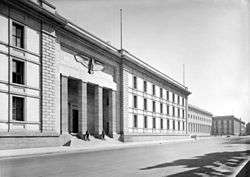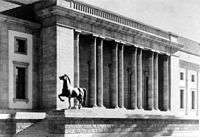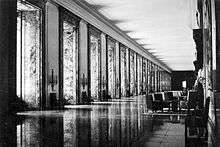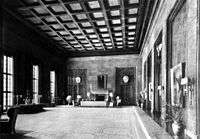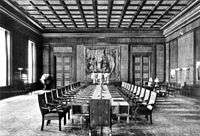Reich Chancellery
| Reich Chancellery | |
|---|---|
| Reichskanzlei | |
 Main building and courtyard formerly located on Wilhelmstraße | |
| General information | |
| Address | Wilhelmstraße 77 |
| Town or city | Berlin-Mitte |
| Country | Germany |
| Coordinates | 52°30′42″N 13°22′55″E / 52.51167°N 13.38194°E |
| Completed | 1939 |
| Renovated | 1939 |
| Destroyed | 1945 |
| Design and construction | |
| Architect | Carl Friedrich Richter |
The Reich Chancellery (German: Reichskanzlei) was the traditional name of the office of the Chancellor of Germany (then called Reichskanzler) in the period of the German Reich from 1871 to 1945. The Chancellery's seat from 1875 was the former city palace of Prince Antoni Radziwiłł (1775–1833) on Wilhelmstraße in Berlin. Both the palace and a new Reich Chancellery building (completed in early 1939) were seriously damaged during World War II and subsequently demolished.
Today the office of the German chancellor is usually called Kanzleramt (Chancellor's Office), or more formally Bundeskanzleramt (Federal Chancellor's Office). The latter is also the name of the new seat of the Chancellor's Office, completed in 2001.
Old Reich Chancellery
When the military alliance of the North German Confederation was reorganised as a federal state with effect from July 1, 1867, the office of a Federal Chancellor (Bundeskanzler) was implemented at Berlin and staffed with the Prussian Prime Minister Otto von Bismarck. After the unification of Germany on January 18, 1871 by accession of the South German states, Bismarck became Reich Chancellor of the new German Empire.
In 1869 the Prussian state government had acquired the Rococo city palace of late Prince Radziwiłł on Wilhelmstraße No. 77 (former "Palais Schulenburg"), which from 1875 was refurbished as the official building of the Chancellery. It was inaugurated with the meetings of the Berlin Congress in July 1878, followed by the Congo Conference in 1884.

In the days of the Weimar Republic the Chancellery was significantly enlarged by the construction of a Modern southern annex finished in 1930. In 1932/33, while his nearby office on Wilhelmstraße No. 73 was renovated, the building also served as the residence of Reich President Paul von Hindenburg, where he appointed Adolf Hitler chancellor on 30 January 1933. The Hitler Cabinet held few meetings here. In 1935 the architects Paul Troost and Leonhard Gall redesigned the interior as Hitler's domicile. They also added a large reception hall/ballroom and conservatory, officially known as the Festsaal mit Wintergarten in the garden area. The latter addition was unique because of the large cellar that led a further one-and-a-half meters down to an air-raid shelter known as the Vorbunker.[1] Once completed in 1936, it was officially called the "Reich Chancellery Air-Raid Shelter" until 1943, with the construction to expand the bunker complex with the addition of the Führerbunker, located one level below.[2] The two bunkers were connected by a stairway set at right angles which could be closed off from each other.[3]
Devastated by air raids and the Battle of Berlin, the ruins of the Old Reich Chancellery were not cleared until 1950.
New Reich Chancellery
In late January 1938, Adolf Hitler officially assigned his favourite architect Albert Speer to build the New Reich Chancellery around the corner on Voßstraße, a western branch-off of Wilhelmstraße, requesting that the building be completed within a year. Hitler commented that Bismarck's Old Chancellery was "fit for a soap company" but not suitable as headquarters of a Greater German Reich. It nevertheless remained his official residence with its recently refurbished representation rooms on the ground floor and private rooms on the upper floor where Hitler lived in the so-called Führerwohnung ("Leader apartment"). Old and New Chancellery shared the large garden area with the underground Führerbunker, where Hitler committed suicide at the end of April 1945.
Speer claimed in his autobiography that he completed the task of clearing the site, designing, constructing, and furnishing the building in less than a year. In fact, preliminary planning and versions of the designs were already being worked on as early as 1935. To clear the space for the New Reich Chancellery, the buildings on the northern side of Voßstraße No. 2–10 had already been demolished in 1937.
Hitler placed the entire northern side of the Voßstraße at Speer's disposal assigning him the work of creating grand halls and salons which "will make an impression on people". Speer was given a blank cheque — Hitler stated that the cost of the project was immaterial — and was instructed that the building be of solid construction and that it be finished by the following January in time for the next New Year diplomatic reception to be held in the new building.
Over 4,000 workers toiled in shifts, so the work could be accomplished round-the-clock. The immense construction was "finished" 48 hours ahead of schedule, and the project earned Speer a reputation as a good organiser, which, combined with Hitler's fondness for Speer played a part in the architect becoming Armaments Minister and a director of forced labour during the war. Speer recalls that the whole work force — masons, carpenters, plumbers, etc. were invited to inspect the finished building. Hitler then addressed the workers in the Sportpalast. However, interior fittings dragged on well into the early 1940s.
In the end it cost over 90 Million Reichsmark, well over one billion dollars today, and hosted the ministries of the Reich.[4]
In his memoirs, Speer described the impression of the Reichskanzlei on a visitor:
| “ | From Wilhelmsplatz an arriving diplomat drove through great gates into a court of honour. By way of an outside staircase he first entered a medium-sized reception room from which double doors almost seventeen feet high opened into a large hall clad in mosaic. He then ascended several steps, passed through a round room with domed ceiling, and saw before him a gallery 480 feet (150 m) long. Hitler was particularly impressed by my gallery because it was twice as long as the Hall of Mirrors at Versailles.
Hitler was delighted: "On the long walk from the entrance to the reception hall they'll get a taste of the power and grandeur of the German Reich!" During the next several months he asked to see the plans again and again but interfered remarkably little in this building, even though it was designed for him personally. He let me work freely. |
” |
The series of rooms comprising the approach to Hitler's reception gallery were decorated with a rich variety of materials and colours and totalled 220 m (725 ft) in length. The gallery itself was 145 m (480 ft) long. Hitler's own office was 400 square meters in size. From the outside, the chancellery had a stern, authoritarian appearance. From the Wilhelmplatz, guests would enter the Chancellery through the Court of Honour (Ehrenhof). The building's main entrance was flanked by two bronze statues by sculptor Arno Breker: "Wehrmacht" and "Partei" ("Armed Forces" and "Party"). Hitler is said to have been greatly impressed by the building and was uncharacteristically free in his praise for Speer, lauding the architect as a "genius". The chancellor's great study was a particular favourite of the dictator. The big marble-topped table served as an important part of the Nazi leader's military headquarters, the study being used for military conferences from 1944 on. On the other hand, the Cabinet room was never used for its intended purpose.
The New Reich Chancellery was badly damaged during the Battle of Berlin in April 1945. Andrei Gromyko visited the Chancellery a few weeks after the fighting had ceased: “We reached it not without difficulties. Ruined, edifices, formless heaps of metal and ferro-concrete encumbered the way. To the very entrance of the Chancellery, the car could not approach. We had to reach it by feet…” The Chancellery, he continues, was almost destroyed. Only walls remained, “riddled by countless shrapnel, yawning by big shot-holes from shells. Ceilings survived only partly. Windows loomed black by emptiness.” The last defense took place inside the Chancellery:
Doors, windows and chandeliers testified on them the imprint of battle, most of them being broken. The lowest floors of the Chancellery represented chaos. Obviously, the garrison of the Citadel fiercely resisted and here exploded not a few shells, bombs and grenades. All around lied heaps of crossbeams and overhead covers—both metal and wooden—huge pieces of ferro-concrete. On both sides of a narrow corridor were disposed certain cells, all eroded by explosions…All this produced grim, distressing impression. If photographies of this underground citadel of Hitler existed, they would become proper illustration to Dante’s hell; only select which circle.[5]
After World War II ended, the remains in what was now East Berlin were demolished by orders of the Soviet occupation forces. Parts of the building's marble walls were said to be used to build the Soviet war memorial in Treptower Park or to renovate the nearby war-damaged Mohrenstraße U-Bahn station.[6] Some of the red marble was used in the palatial Underground stations in Moscow. Also a heater from Hitler's rooms was placed in a Protestant hospital.[7]
While the western half of the premises were seized for the "death strip" of the Berlin Wall in 1961, a Plattenbau apartment block and a kindergarten were built on the eastern corner with Wilhelmstraße in the 1980s.
Gallery
|
See also
References and citations
- ↑ Lehrer, Steven (2006). The Reich Chancellery and Führerbunker Complex. An Illustrated History of the Seat of the Nazi Regime. Jefferson, NC: McFarland. p. 117. ISBN 0-7864-2393-5.
- ↑ Lehrer, Steven (2006). The Reich Chancellery and Führerbunker Complex. An Illustrated History of the Seat of the Nazi Regime. Jefferson, NC: McFarland. pp. 117, 119. ISBN 0-7864-2393-5.
- ↑ Mollo, Andrew; Ramsey, Winston, eds. (1988). The Reichs Chancellery and the Berlin Bunker then and now. After the Battle. 61. London: Seymour Press. p. 28.
- ↑ "Who Was Who in Nazi Germany", Nuremberg Trials Project. Harvard University. Retrieved 2 aug 2011
- ↑ А. Андрей Громыко, Памятное, Москва: Политиздат, 1988, p 216-217, translated in Maks Ostrovski, The Hyperbole of the World Order, Lanham: Rowman & Littlefield, 2006, p 144-145.
- ↑ Hans-Ernst Mittig: "Marmor der Reichskanzlei", in: Dieter Bingen / Hans-Martin Hinz (Hrsg.): Die Schleifung / Zerstörung und Wiederaufbau historischer Bauten in Deutschland und Polen. Harrassowitz Verlag, Wiesbaden 2005, ISBN 3-447-05096-9.
- ↑ Architektur der Angst einestages – Zeitgeschichten auf Spiegel Online
General
- Speer, Albert (1970). Inside the Third Reich. New York: Macmillan. LCCN 70-119132.
- Kellerhoff, Sven Felix (2006). Berlin unterm Hakenkreuz (Berlin under the Swastika). Berlin: Berlin Edition be.bra Verlag GmbH. ISBN 978-3-8148-0147-6.
- Allied Intelligence Map of Key Buildings in Berlin (Third Edition, 1945)
Further reading
- Lehrer, Steven (2006). The Reich Chancellery and Führerbunker Complex: An Illustrated History of the Seat of the Nazi Regime. McFarland. p. 214. ISBN 0-7864-2393-5.
- Lehrer, Steven (2002). Hitler Sites: A City-by-city Guidebook (Austria, Germany, France, United States). McFarland. p. 224. ISBN 0-7864-1045-0.
- Taylor, Blaine. Hitler's Headquarters: From Beer Hall to Bunker, 1920–1945.
- Cowdery, Ray and Josephine. The New German Reichschancellery 1938–1945.
- Schönberger, Angela (1981). Die Neue Reichskanzlei Von Albert Speer. Zum Zusammenhang von nationalsozialistischer Ideologie und Architektur. Berlin: Berlin: Gebr. Mann.
- Scobie, Alex (1990). Hitler's State Architecture: The Impact of Classical Antiquity. University Park and London: Pennsylvania State University Press.
- Taylor, Robert (1974). The Word in Stone. The Role of Architecture in the National Socialist Ideology. Berkeley: University of California Press.
- Speer, Albert (1940). Die Neue Reichskanzlei / Architekt Albert Speer. München: Eher Verlag.
- Neubauer, Christoph (2010). Stadtführer durch Hitlers Berlin (Deutsch/English). Frankfurt (Oder): Flashback Medienverlag. ISBN 978-3-9813977-0-3.
- Neubauer, Christoph (2014): Die Reichskanzlei – Architektur der Macht, Band 1 (1733–1875). Chr. Neubauer Verlag, Großschönau 2014, ISBN 978-3-9813977-1-0.
Documentary
- Ruins of the Reich DVD R.J. Adams (Third Reich architecture ruins)
- Hitlers Berlin 3D – Die Reichskanzlei Interaktiv DVD. Flashback Medien UG, 978-3-9813977-4-1 (Computer Animation of the Reich Chancellery).
- "Albert Speer's New Reich Chancellery" DVD
25fps-filmproduction GmbH & Co. KG (3D Computer Animation "Construction History and Street Facades" and "Garden Facades and Court of Honor")
External links
| Wikimedia Commons has media related to Reichskanzlei. |
| Wikimedia Commons has media related to Neue Reichskanzlei. |
- Photographs of the Reich Chancellery
- Animation of the Reich Chancellery
- 3D-stereoscopic images of Chancellery
- Website of the German History Museum with photographs and information
- Photographs of the Reich Chancellery
Coordinates: 52°30′42″N 13°22′55″E / 52.51167°N 13.38194°E


